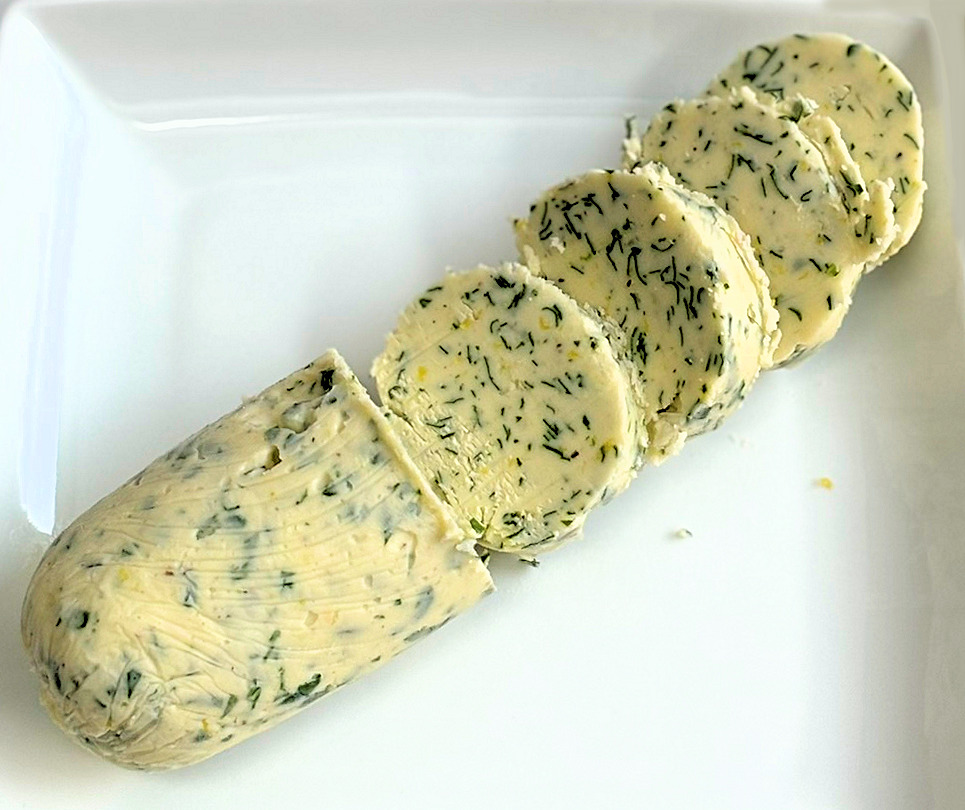Herb, lemon and garlic flavoured butter is the perfect topping on a steak, better than the fanciest sauce. But chilli crisp butter and chive butter are also worth trying: three flavours of compound butter in one recipe.

Bread and butter
The best thing about posh restaurants is the bread course. I call it a ‘course’ because often it is quite elaborate.
It might be an old-school experience, with the waiter bearing a basket of rolls and a pair of tongs, elegantly planting selected bread on your side plate, with you secretly wishing you were not too embarrassed to ask for two.
It might be a dedicated course in a tasting menu, of bread more generously sized because all the other courses are miniscule.
It also could be a stingy outfit that charges for bread as an item on the menu, which makes all the self-respecting French and Italian restaurateurs frown.
In any case though the bread comes with a dip, a spread or a butter (unless you’re in France). I am usually secretly disappointed if it’s the olive oil option, because even though I love oil-dripping focaccia, I’m a sucker for bread and butter. Especially if it is an intriguing pile or cube of flavoured, or compound butter.
What is compound butter?
It sounds scientific but compound butter is simply flavoured butter.
Arguably the most famous and the original of those is Café de Paris butter, served with a steak. It is quite a complicated recipe and varies from chef to chef, so I’ll argue that my herb lemon butter below is perfectly on par with the Paris.
Compound or cultured butter?
The two are sometimes confused but are quite a different thing, though cultured butter can be used to make a compound one.
So whilst compound is butter with one or more ingredients added to it for a distinctive flavour, cultured butter is an artisan, naturally fermented butter, with a live bacteria culture added to cream to make it turn tangy and slightly sour, before churning. A butter made from cream that went off, basically.
How to make compound butter?
The Danes have a word for thickly buttered bread: tandsmør, ‘tooth butter’, meaning the butter is so thickly layered on your bread, your teeth leave bite marks. And I’m the same.
If, like me, you’re a butter fiend, making compound butters is the easiest, almost-instant gratification. The only risk is for your cholesterol levels as you won’t be able to resist putting those butters on everything, in copious amounts.
The method requires very soft but not melted butter, and I prefer to use unsalted as you are then more in control of adjustments to taste.
The flavour ingredients can be finely chopped, grated or pounded in pestle and mortar. The exceptions are those compound butters, like the chilli crisp one below, where you simply whisk in a spoonful of flavouring ingredient.
You can in addition whisk the finished product fluffy if you’re planning on serving it in dainty containers on the table. Otherwise you can scrape the butter onto a length of cling film, shape a log and cut slices of it when it’s chilled. That will work the best for the herb lemon butter when it’s to be served on steak.
How to use compound butters?
Herb lemon butter: it’s definitely the best suited with steak. Place a disc of chilled compound on your beef and let it gently melt onto each morsel. Beats any steak sauce in my view.
It is also fabulous on roast chicken, and even a boring, bland chicken breast will be transformed if anointed with herb lemon butter.
Chilli crisp butter: chilli crisp oil, aka chilli oil is the condiment taking western kitchens by storm, even dribbled over ice cream.
Mixing oil into butter might seem bonkers but the chilli crisp is more crisp chilli than oil and it makes an amazing condiment. You can spread it on bread or toast, but try it with plain cooked vegetables, especially bland cauliflower, to experience a magic transformation.
Chive butter: I advise to pound chopped chives in pestle and mortar before mashing into butter. It isn’t strictly necessary but pounding helps release the flavour essence from chives as well as vibrant colour to tinge the compound butter. It’s wonderful on bread, especially topped with cottage cheese, and fantastic on baked potatoes.
More compound butter flavours
If you don’t feel like experimenting, try the classic staples: miso, Marmite, garlic or seaweed butter. If you feel more adventurous, you could test horseradish or wasabi, anchovy or garam masala.
You can of course flavour butter with sweet ingredients, like honey, jam, fruit or vanilla essence and enhance your next afternoon tea.
There is also the most wonderful, dangerously addictive date butter which I love so much, it merits a dedicated recipe.
More condiment recipes
Kewpie-style mayonnaise, the umami bomb of a condiment, which you can make at home in exactly one minute. A stick blender and a tall jar make true magic happen.
Hot honey, the sweet and spicy condiment that is drizzled over pizzas, cottage cheese and roast chicken everywhere, is very easy to make very well and even easier to make on the quick, with a shortcut.
Cranberry ketchup is a sweet and sour sauce, a perfect condiment for cold meats or roasts. I’m going to serve it alongside duck for Christmas dinner this year.